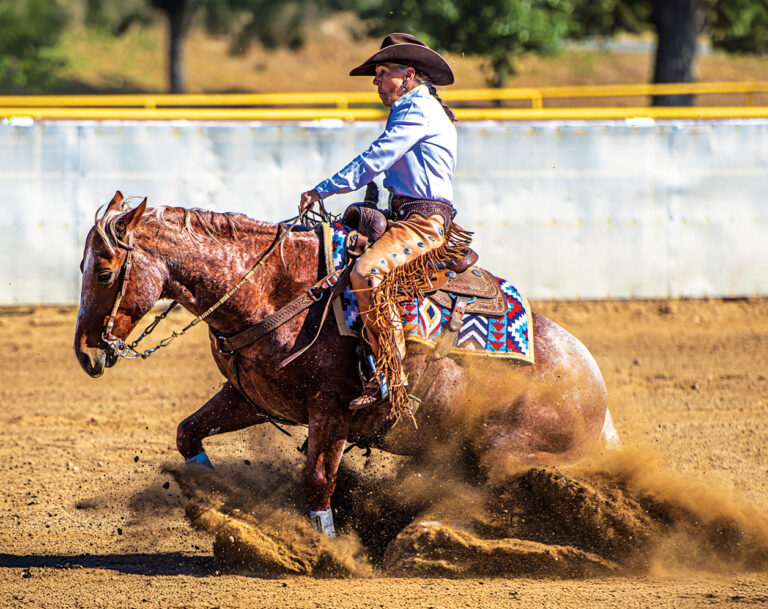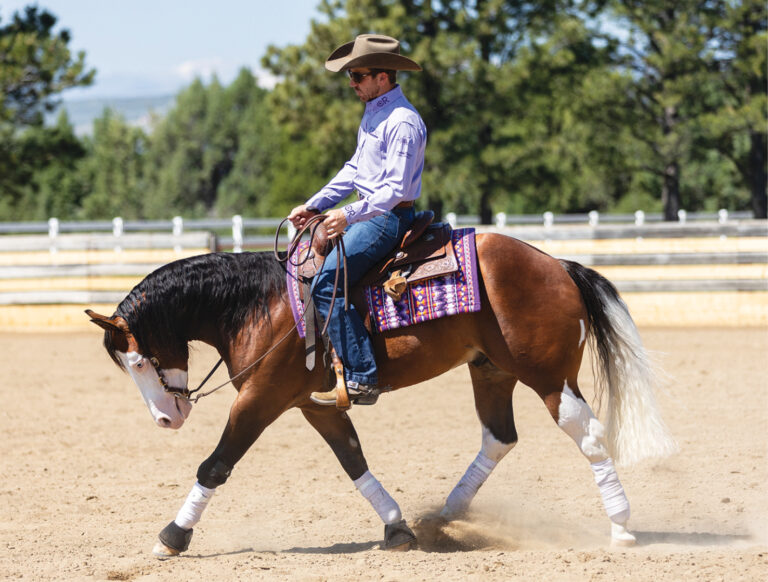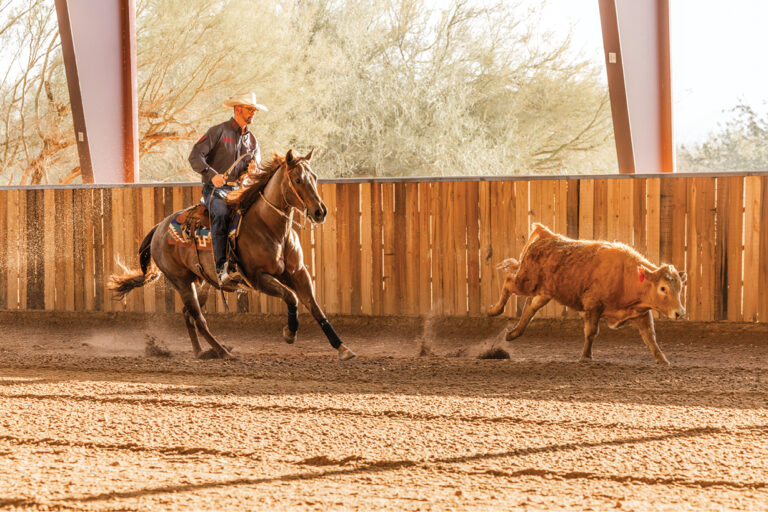He called himself “the horse’s lawyer” because he always took the horse’s side of things. He sought to find and share ways of influencing a horse that honored the animal’s spirit.
Today, the ever-growing acceptance of noncoercive training methods—that is, helping the horse understand what you want, then use his own brain to figure out how to comply—is testament to the genius and gentle persistence of the late Tom Dorrance.
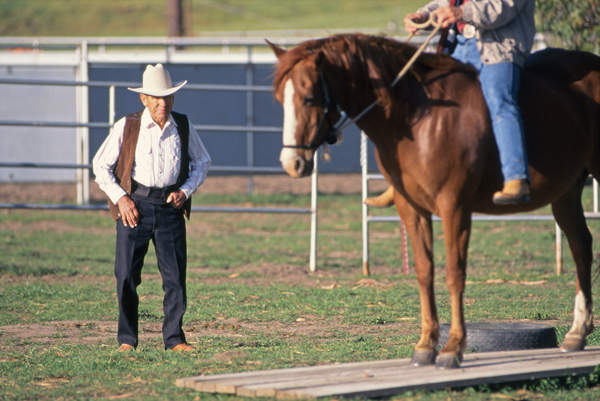
In their 2005 book The Revolution in Horsemanship, Robert M. Miller, DVM, and Rick Lamb place Dorrance in the forefront of the sea change that is natural horsemanship. Either directly or through protégé Ray Hunt, Dorrance inspired a host of horsemen committed to promoting a horse-centric way of doing things. Most of today’s natural horsemanship clinicians count him as a major influence.
Learn straight from the source with Tom Dorrance’s book, True Unity: Willing Communication Between Horse & Human. (As an Amazon Associate, we earn from qualifying purchases made through affiliate links.)
Brilliant, humble horseman. I had the honor of meeting Tom in 1997 while researching his H&R profile, “The Horse’s Advocate.” I came away from that meeting understanding why this brilliant yet humble horseman, born in the early 1900s outside Joseph, Oregon, inspired an almost transcendent admiration among those who knew him.
And, as I continued over the years to write about top riders and trainers, I began to appreciate his legacy even more. Indeed, the world of mainstream horse training is different from what it would’ve been had Tom Dorrance not come along.
In this article, we’ll look at some of the ways this legendary horseman, who died in 2003, has influenced—and continues to influence—the world of performance horse training.
[Learn how Tom Dorrance and Warwick Schiller are similar.]
‘He Changed How I Think’
Craig Johnson is a 14-time world champion in reining, a National Reining Horse Association Million Dollar Rider, a two-time NRHA Futurity champion, and a member of the gold-medal-winning 2002 World Equestrian Games U.S. team. When I contacted him for this article, he said he’d love to visit about Tom Dorrance.
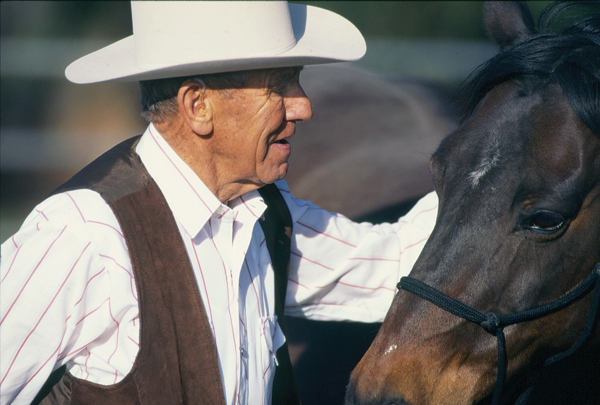
“He did something no one else could do,” the Gainesville, Texas, trainer told me. “He changed how I think. He taught me how to work with a horse from the horse’s perspective, and how to observe the differences among horses. He stressed breaking things down into smaller pieces instead of just looking at whether or not a horse is ‘getting it done.’”
Get a copy of Ray Hunt’s Book, Think Harmony With Horses.
Johnson’s earliest influences—his father, plus trainer Jack Brainard and Ray Hunt—shared some of Dorrance’s philosophies with him. Then, when Craig was in his mid-20s, he attended a three-day Dorrance clinic.
The feet-brain connection. He particularly remembers a money-winning reining horse brought by a non-pro owner, who was trying to ride the gelding as successfully as his trainer had.
“When he tried to run down and stop, the horse braced up and skipped like a flat rock on a pond,” Johnson recalls. “Tom had his helper put a blue plastic tarp down in the arena. ‘Now go ride over that,’ he told the guy.”
It took the better part of an hour to get the horse over the tarp.
“But by the end,” Johnson continues, “the guy could trot and lope his horse over it from all directions. Then Tom told him to stop again—and it was beautiful. Getting the horse’s feet to move over the tarp had unlocked his brain. I learned from this that the connection between a horse’s feet and his brain is incredible.”
Johnson also realized that obstacle work can be a way of building confidence and creating trust between horse and rider.
“Then you can work on whatever’s your real problem in a more enlightened way,” he says.
Watch Tom Dorrance for yourself in his Colt Starting & Beyond two-DVD set.
The payoff. From then on, obstacle work and cross training became an integral part of the trainer’s regimen. Most recently, the approach paid off handsomely with the mare Smart And Angelic, with whom Johnson won the junior ranch horse pleasure championship at the 2014 American Quarter Horse Association World Show.
“I trained her to be a reiner, but with cross training you find out how things connect in a different way,” he explains. “Tom always said to let the horse tell you what he’s good at, and cross training with obstacles or other disciplines enables you to do that. The mare was a good reiner, but I could tell there was more horse there than that.
Cowboy dressage. “Then, while preparing her for the World Show, I spent a lot of time doing cowboy dressage as well as obstacles, and that got her so completely ready for the ranch pleasure.
“To this day,” he concludes, “whenever I get in a ‘situation’ with a horse, I think of Tom and how he improvised solutions at that clinic.”
[New horse? His first show? Follow Craig Johnson’s advice.]
‘Open the Door’
Sandy Collier is a member of the National Cowgirl Hall of Fame, an AQHA world champion trainer, and the only woman (so far!) to win the open division of the world’s toughest cow horse event, the National Reined Cow Horse Association Snaffle Bit Futurity.
Wild and wooly was ‘the way.’ Collier says that back in the day, before it was common to consider how a horse thinks and responds, starting an unhandled colt could be “wild and wooly.”
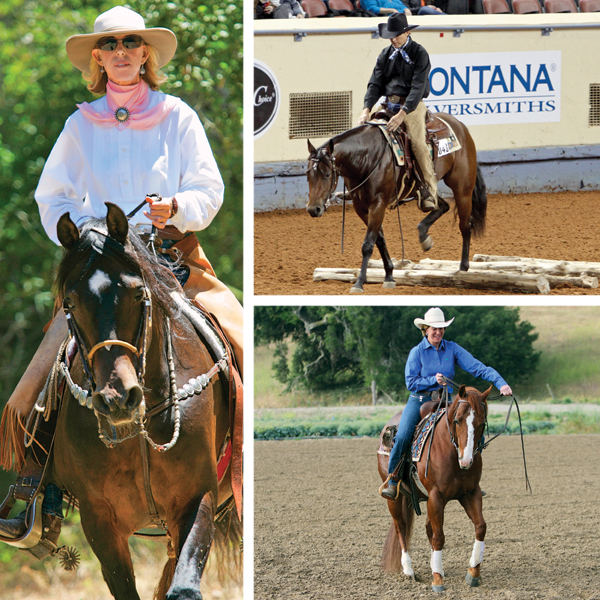
“For the lack of knowing how to do it differently, it was ‘my way or the highway,’” observes the Buellton, California, trainer, recalling how she started Spanish Barbs on a 3,600-acre ranch in Santa Barbara in the 1970s.
“When the dust settled, if the horse still had the saddle on, it was a good day. That was horsebreaking, cowboy-style, at the time.”
Finding the holy grail. Then, as the influence of Dorrance and his disciples began to spread, the realization of a different, better way began to sink in.
“The ‘holy grail,’ as it were, is to make the right thing easy for the horse and the wrong thing difficult,” Collier says, using the words of Ray Hunt. “You ‘open the door’ to what you want him to do, and simultaneously ‘bar the way’ to what you don’t want—by making it uncomfortable or difficult. Then the horse can figure out and choose the option you want.”
Collier used this philosophy on the way to her historic 1993 Snaffle Bit Futurity championship on Miss Rey Dry.
Add a snaffle bit to your tack collection with this Colorado Saddlery Montana Rose Dee-Ring.
Sensitive, terrified. “She was a sensitive mare and terrified of the signs in the arena the night before the finals. So it was work, work, work in the middle of the pen, then I’d move her as close to the wall as I could and let her rest there. Each time I got her a little closer. She also spent the night there with a haybag attached to the scariest sign.
“The next day, she was brilliant,” Collier continues. “I can only imagine what the finals would’ve looked like if I’d tried to force her out to the wall or gotten after her for being scared—history would’ve been very different.”
[Sandy Collier’s advice on how to ‘ride smart.’]
‘Put the Horse on Your Team’
Jon Roeser is an NRCHA Million Dollar Rider, Snaffle Bit Futurity champion, and winner of the World’s Greatest Horseman title. Through his father, the late NRCHA Hall of Fame member Jim Roeser, Jon learned about both Tom Dorrance and Ray Hunt; later he watched Dorrance start colts at the Ward Ranch.
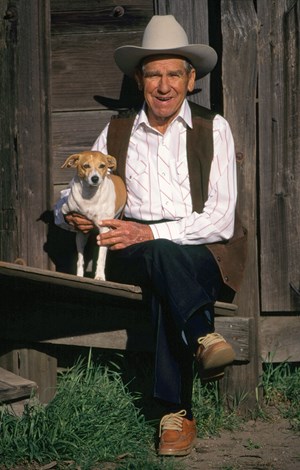
“He’d take all the fillies and put them in a pen together,” recalls the trainer, who today has ranches in both California and Idaho. “A bunch of them would have riders—he started the 2-year-olds together, not one at a time, so it was the same environment for them as in a pasture.
Down at their level. “Then, when everyone else would go off for lunch, Tom would stay with the horses. He had his stool, a folding chair, his flag, a water bottle. He’d stay down at the horses’ level, so they wouldn’t be intimidated. Then he’d sit and wait.”
Roeser says both Dorrance and Hunt strove for harmony with a horse. “There was something spiritual there that gave them the patience and time they needed to be soft and kind. Plus Tom had a genius mind when it came to horses—like an Einstein, really, in figuring things out.”
Dorrance’s protégé Ray Hunt excelled at expressing the older horseman’s ideas in ways people could better understand. Jaton Lord, a performance horse trainer in Skull Valley, Arizona, is Hunt’s grandson.
Think about stuff. “Grandpa always said to use your brain,” he says. “Think about stuff. Even when he signed his name, he put ‘Think’ next to it. When you stop using your mind with a horse, that’s when stuff doesn’t go well.”
At the age of about 4, Lord met his grandpa’s mentor, marking the occasion by roping Dorrance’s foot.
“He fell on the ground, bawling like a cow, and I went and ‘branded’ him,” says the trainer. “Tom had a way of lightening a mood and bringing out the best in horses and in people. He particularly wanted to make things interesting for the horse, so the animal would feel part of a team—and therefore work with you.”
Lord says he uses the same approach today with the horses he trains.
“My goal is to get horses into the show pen, but at the end of the day, I just want each of them to be the best horse possible. I want to be able to send them home and know they’ll give their best—and their owners will be happy to ride them.”
[Read about Ray Hunt and Tom Dorrance’s influence on the author of this article.]
‘Keep Learning’
Sheila Varian, an influential and award-winning breeder of Arabian horses, is also an accomplished trainer in the vaquero tradition. The Arroyo Grande, California, horsewoman credits Dorrance with the soft touch she uses in all her training. Dorrance visited her often in the mid-1960s during his early period of learning and sharing with others.
Rhythm and flow. “He liked any good horse, and he liked mine,” she recalls. “In his first visit, he showed me how coaxing a horse’s head down resulted in relaxation—chewing and licking of the lips. I don’t know if he was musical per se, but he definitely had rhythm and flow with horses.
“He also read them extremely well. And when anyone would complain about a horse, he’d find the good in it.”
Varian says Dorrance’s intuition worked nonstop, and he loved to try new things—such as riding a horse with just a string through its mouth, something she and he did on occasion.
“He was fascinated by all the different ways you could train a horse,” she says. “He was an educator who never stopped wanting to learn.”
Maybe you could think about this. As a teacher, with horses and humans alike, Dorrance sought to inspire rather than dictate.
“He’d offer a suggestion by saying, ‘Maybe you could think about this.’ And he always tried to make everything my idea,” Varian adds with a laugh. “But I recognized him as special. And most often it wasn’t my idea, it was his.”
Ultimately, Dorrance’s methods have found their way into mainstream training simply because they work so well.
“There are those who say they don’t have time for the ‘natural horsemanship stuff,’” Varian muses, “but if you make mistakes in the beginning, you have to fix those mistakes and the whole process takes longer. Tom offered the horse training without the mistakes, and when you do that, training goes quicker, with better results.”
And is easier on the horse—Dorrance’s primary concern.
“Tom simply loved horses,” Varian says, “and he wanted to do right by them.”
That he has done, without question, in his life’s work and in his ongoing influence. Indeed, the best of horse training today owes a great deal to the lasting legacy of Tom Dorrance.
[Learn what Sheila Varian (and others) had to say about gender bias among horses.]
Author’s Note….Natural Horsemanship, A History: Though Tom Dorrance’s influence has revolutionized horse training, many of the principles at the heart of his methods have been around for centuries. Moreover, other voices, including that of Tom’s brother Bill Dorrance, have promoted similar ideas. For a full look at the history of horse-centric training methods, see “A New Era for Horsemanship?”

